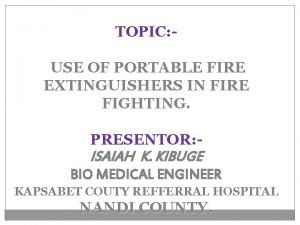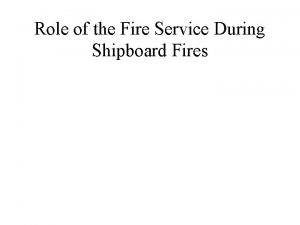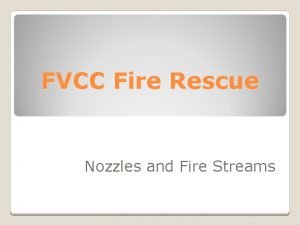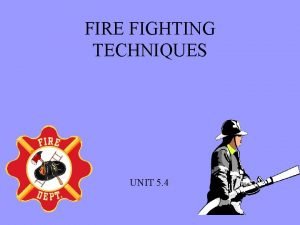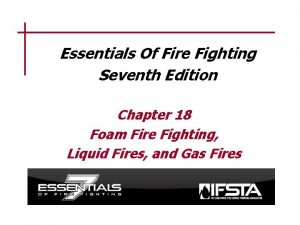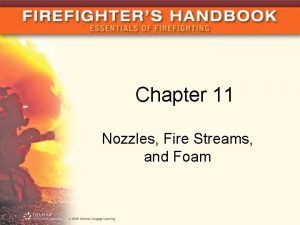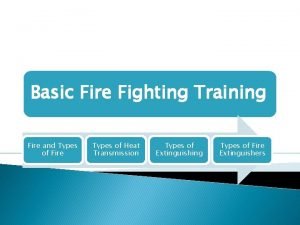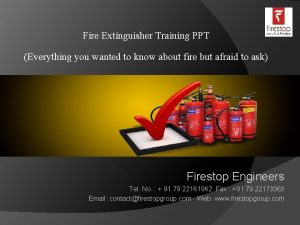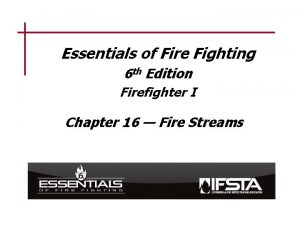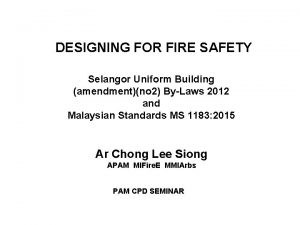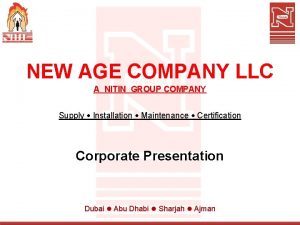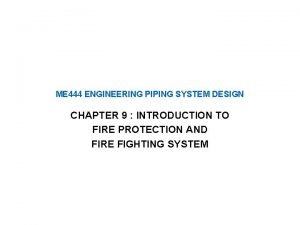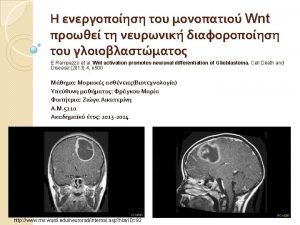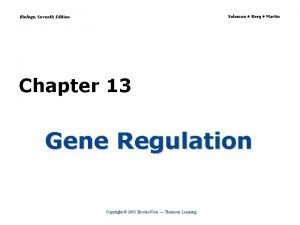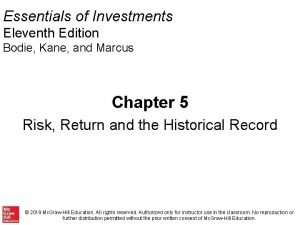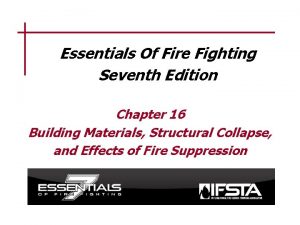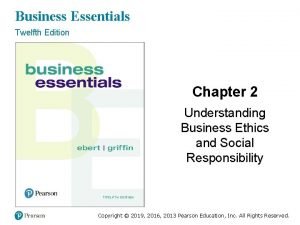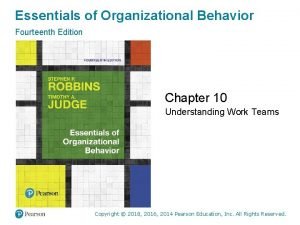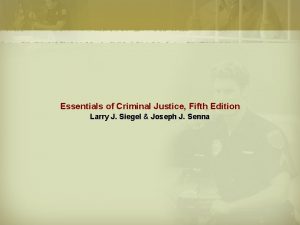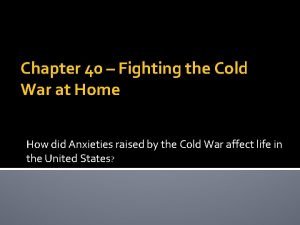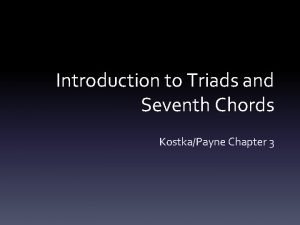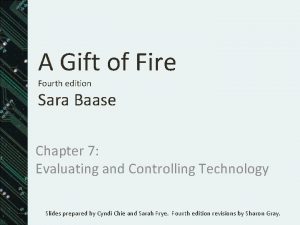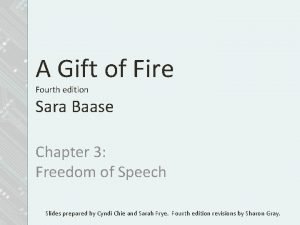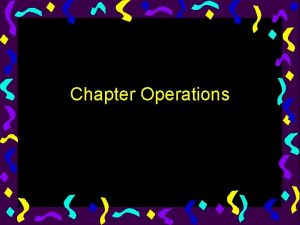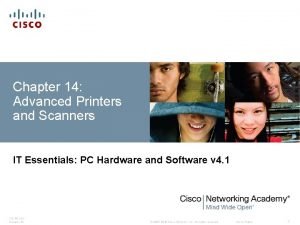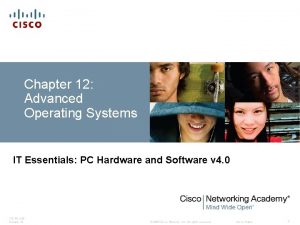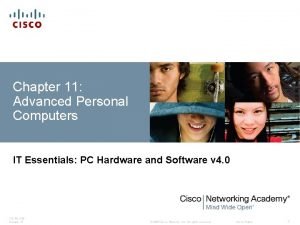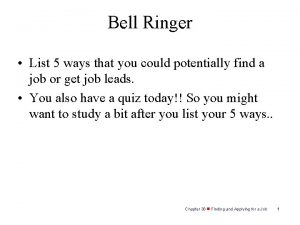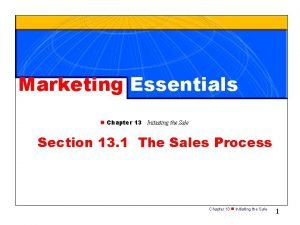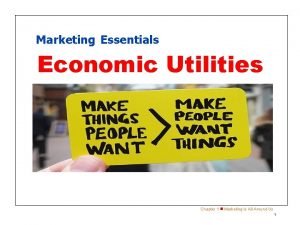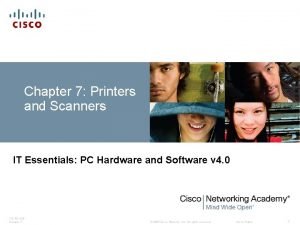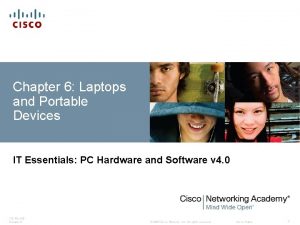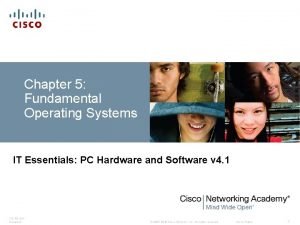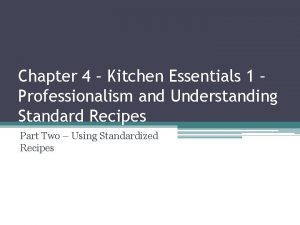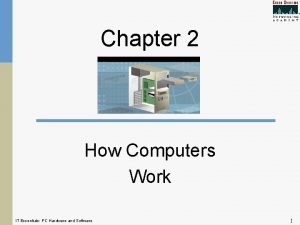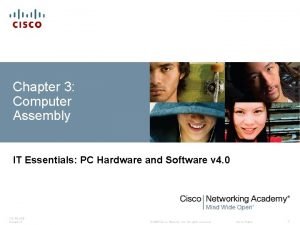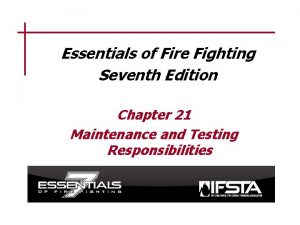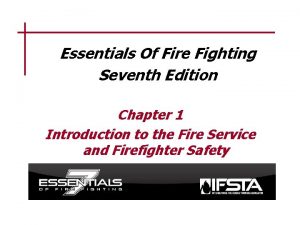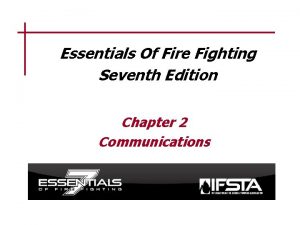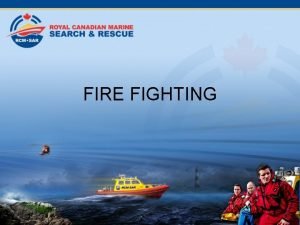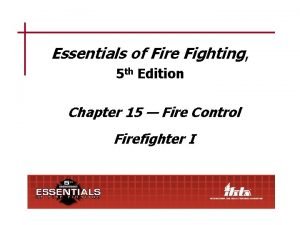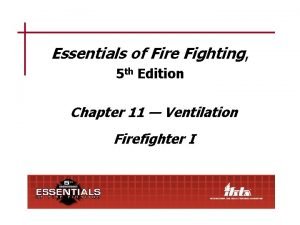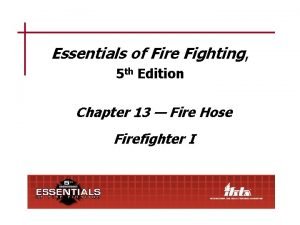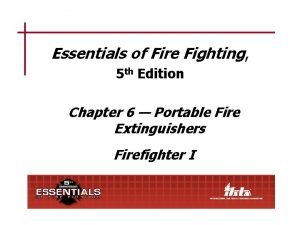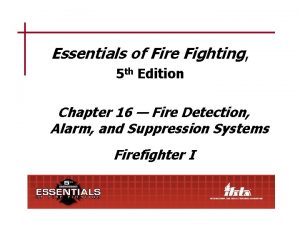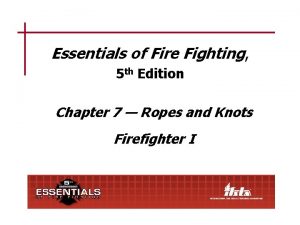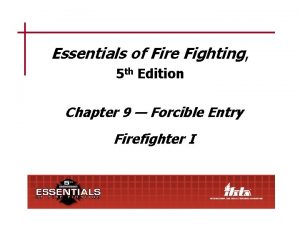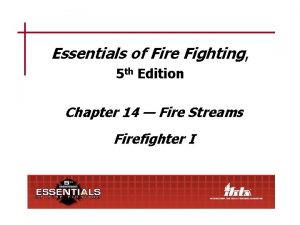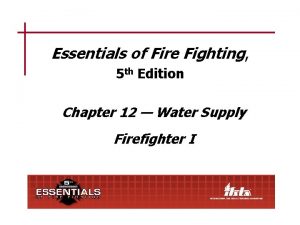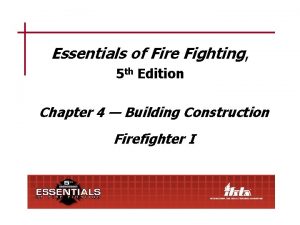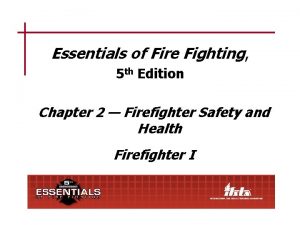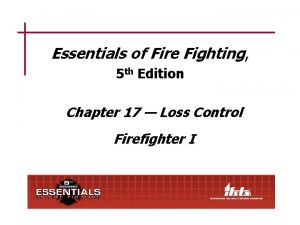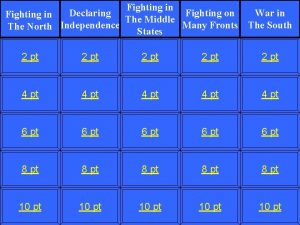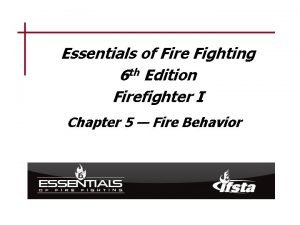Essentials Of Fire Fighting Seventh Edition Chapter 6
































































- Slides: 64

Essentials Of Fire Fighting Seventh Edition Chapter 6 Portable Fire Extinguishers

Learning Objective 1 Distinguish among the five classifications of portable fire extinguishers. 6– 1

Portable Fire Extinguishers • Classified according to type of fire they are designed to extinguish • Some are suitable for more than one class of fire; some only designed for a particular class • Should only be used for intended fire type(s) • Certain extinguishing agents are only effective on certain classes of fuels 6– 2

Fire Extinguisher Ratings 6– 3

Classification Of Fire 6– 4

Class A — Ordinary Combustibles Class A fuel examples • • • Textiles Paper Plastics Rubber Wood Extinguishing agents • Water-based agents • Dry chemicals 6– 5 (Cont. )

Class A — Ordinary Combustibles Class A extinguishers • Rated from 1 -A through 40 -A • Rating is based on amount of water and duration and range of discharge • To calculate the capacity, multiply the number in front of “A” by 1¼ gal (5 L) 6– 6

Class B — Flammable And Combustible Liquids Class B fuel examples • • Alcohol Gasoline Lubricating oils Liquefied petroleum gas (LPG) Extinguishing agents • Carbon dioxide (CO 2) • Dry chemicals • Class B foam (Cont. ) 6– 7

Class B — Flammable And Combustible Liquids Class B extinguishers • Rated from 1 -B through 640 -B • Rating is based on approximate square foot (meter) area of flammable liquid fire that a nonexpert operator can extinguish using one full extinguisher • Expected to extinguish 1 square foot (0. 09 m 2) for each numerical rating or value 6– 8

Class C — Energized Electrical Equipment Extinguishing agents • Water and water-based agents cannot be used until electricity is shut off • Class C agents will not conduct electricity • Once power supply is off, treat as a Class A or B fire Class C extinguishers • Not specifically rated based on capability tests • Class C rating assigned in addition to Class A and/or B rating 6– 9

Class D — Combustible Metals And Alloys Class D fuel examples • Titanium • Lithium • Magnesium • Potassium • Sodium Magnesium • Fires identified by bright white emissions during combustion • Common uses: cameras, laptops, luggage, box springs, automobile wheels and transmissions 6– 10 (Cont. )

CAUTION The use of water or water-based agents on Class D fires will cause the fire to react violently, emit bits of molten metal, and could injure nearby firefighters. 6– 11

Class D — Combustible Metals And Alloys Extinguishing agents • Dry powder works best • Do not confuse dry powder with dry chemical • Only use Class D rated extinguishers Class D extinguisher ratings • Variety of factors considered during testing • No numerical rating • Class D agents not rated for use on other classes of fire 6– 12

CAUTION Use only Class D rated fire extinguishers to extinguish metal fires. 6– 13

Class K — Combustible Cooking Oils Class K fuel examples • Vegetable or animal fats • Oils that burn at high temperatures Locations • Private homes • Commercial and institutional kitchens • Industrial cooking facilities 6– 14 Courtesy of Steven A. Stokely, Sr. and Midwest Kosher Deli, South Bend, IN (Cont. )

Class K — Combustible Cooking Oils Class K extinguishers • Wet chemical systems and portable extinguishers • Work because of saponification • Wet chemical agents contain alkaline mixture to suppress vapors and smother the fire • To meet the minimum criteria for Class K rating, agents must extinguish fire with surface area of 2. 25 square feet (0. 2 m 2) 6– 15

REVIEW QUESTIONS List and describe the five classifications of fire. How are portable fire extinguishers rated? 6– 16

DISCUSSION QUESTION Create a mnemonic device (memory device) such as an acronym or phrase to help you remember the five classifications of fire. 6– 17

Learning Objective 2 Distinguish among the various types of portable fire extinguishers. 6– 18

Methods Used To Extinguish Fire Smothering Cooling Chemical flame inhibition Saponificati on 6– 19

Extinguishing Agent Characteristics 6– 20

Operational Characteristics Of Portable Fire Extinguishers (Cont. ) 6– 21

Operational Characteristics Of Portable Fire Extinguishers 6– 22

NOTE Water-type extinguishers must be protected against freezing if exposed to temperatures lower than 40°F (4°C). Protection options include adding antifreeze to the water or storing them in warm areas. 6– 23

Portable Fire Extinguisher Mechanisms Manual pump Stored pressure Pressure cartridge 6– 24

Common Portable Fire Extinguishers Pump-type water Storedpressure CO 2 Dry powder Wet chemical storedpressure Clean agent 6– 25 Aqueous film forming foam (AFFF) Storedpressure water Dry chemical

Pump-Type Water Extinguishers Intended primarily for ground cover fires May be used for small Class A fires Usually worn on operator’s back Use manually operated slide pump Nozzle produces straight stream, fog, or water-mist pattern 6– 26

Stored-Pressure Water Extinguishers Also called • Air-pressurized water (APW) extinguishers • Pressurized water extinguishers Uses • Small Class A fires • Small hot spots during overhaul (Cont. ) 6– 27

Stored-Pressure Water Extinguishers Function • Store water and compressed air or nitrogen • Gauge on valve assembly displays the pressure level • Stored pressure forces water up siphon tube and out the hose Some include Class A foam concentrate • • To increase effectiveness Serves as wetting agent Can aid in extinguishing deep-seated fires Reduces surface tension of water 6– 28 (Cont. )

Stored-Pressure Water Extinguishers Water-mist • Deionized water • Nozzle produces fine spray • Safe to use on Class C fires • Fine spray enhances water’s cooling and soaking characteristics and reduces scattering of burning (Cont. ) material 6– 29

Stored-Pressure Water Extinguishers Wet chemical • Class K fires • Potassium-based, low-p. H agent that extinguishes by saponification • Carried on some apparatus 6– 30

Aqueous Film Forming Foam (AFFF) Extinguishers Uses • Class B fires • Useful in combating fires or suppressing vapors from small fuel spills • Most effective on static pools of flammable liquids • Not suitable for Class C, D, or K fuels • Not suitable for flowing fuels or fuel under pressure 6– 31 (Cont. )

NOTE Some manufacturers market AFFF foam concentrates that can be used on Class A fires. 6– 32

Aqueous Film Forming Foam (AFFF) Extinguishers Differences from stored-pressure water extinguishers • Tank contains specified amount of concentrate mixed with water to produce foam solution • AFFF has air-aspirating foam nozzle Function and application • Water/AFFF solution expelled using compressed air or nitrogen • Finished foam floats on fuel surfaces and creates a vapor seal to prevent reignition • Do not apply foam directly onto the fuel • Allow foam to rain down onto fuel’s surface or deflect foam off nearby object 6– 33

Clean Agent Extinguishers Uses • Cool and smother Class A and B fires • Nonconductive and can extinguish Class C fires • Developed to replace Halons Halogenated agents Halotron • U. S. EPA approved alternative clean agent • Does not harm the ozone 6– 34 Courtesy of Ansul Corp. • Effective for fires containing materials that are easily damaged by water or dry chemicals • Damaging effect on ozone layer

Carbon Dioxide (CO 2) Extinguishers (Cont. ) 6– 35

Carbon Dioxide (CO 2) Extinguishers Uses • Handheld or wheeled units • Most effective for Class B and C fires Function and application • • • Limited discharge reach Winds disperse extinguishing agent Do not require freeze protection Store CO 2 under its own pressure as liquefied gas Discharges agent through plastic or rubber horn at the end of a hose or tube Gaseous discharge usually forms dry ice crystals or “snow” Gas displaces oxygen and smothers the fire Little cooling effect (Cont. ) Does not suppress surface vapors; fuels may reignite 6– 36

CAUTION When the extinguishers discharge carbon dioxide, a static electrical charge builds up on the discharge horn. Touching the horn before the charge has dissipated can result in a shock. 6– 37

Carbon Dioxide (CO 2) Extinguishers Wheeled CO 2 units • Larger than handheld units • Usually have 50 - to 100 -pound (25 to 45 kg) capacities • Most commonly used in airports and industrial facilities • Operator must wheel unit to fire, then deploy the hose, otherwise operation is same as handheld units 6– 38

Dry Chemical Extinguishers Dry chemical Class A-B -C fires Dry powder Only Class D fires Class B-C fires (Cont. ) 6– 39

Dry Chemical Extinguishers One of the most common portable extinguishers Regular B: C Ratings Multipurpose and A-B -C Commonly used dry chemicals • • • Sodium bicarbonate Potassium bicarbonate Urea-potassium bicarbonate Potassium chloride Monoammonium phosphate 6– 40 (Cont. )

Dry Chemical Extinguishers Additives and agents • Make agents moisture-resistant and prevent them from caking • Keeps agents ready to use after long storage time • Many agents can be mildly corrosive • Some compatible with foam Application • Application may result in cloud of airborne particulate • Agents are nontoxic • Particulate cloud may reduce visibility and create respiratory problems • Class A fires — Direct agents at the fuel to cover it • Once flames are knocked down, apply agent intermittently on smoldering areas 6– 41

Dry Chemical Extinguishers — Handheld Units • • • Similar design to air-pressurized water extinguishers Agent storage tank maintains constant pressure of about 200 psi (1 400 k. Pa) Uses nitrogen or carbon dioxide pressurizing gas Pressure cartridge connected to agent tank Operator pushes plunger to release gas from cartridge and pressurize the tank Uses nitrogen or carbon dioxide as the pressurizing gas 6– 42

CAUTION When pressurizing a cartridge-type extinguisher, do not place your head or any other part of your body above the top of the extinguisher. If the fill cap was not properly screwed back on, the cap and/or a cloud of agent can be forcibly discharged. 6– 43

Dry Chemical Extinguishers — Wheeled Units (Cont. ) 6– 44

Dry Chemical Extinguishers — Wheeled Units Uses • Class A, B, and C fires Function and application • Agent in one tank and pressurizing gas in a separate cylinder • Position the unit, then stretch hose out completely • Introduce pressurizing gas into agent tank and allow it to pressurize before opening the nozzle • Significant nozzle reaction • Agent is applied in same manner as handheld, cartridge-type dry chemical extinguishers 6– 45

CAUTION The top of the extinguisher should be pointed away from the operator and any other nearby personnel when pressurizing the unit. 6– 46

Dry Powder Extinguishers Uses • Class D fires • No agent will work for all combustible metals (Cont. ) 6– 47

Dry Powder Extinguishers Function and application • Powdered agents applied with handheld or wheeled extinguishers or a shovel or scoop • Completely cover burning area with the agent • Apply agently • Avoid scattering burning material • Additional applications as needed to cover hot spots • After extinguishment, leave material undisturbed until it is completely cooled 6– 48

CAUTION Water applied to a combustible metal fire results in a violent reaction that intensifies the combustion and causes bits of molten material to spatter in every direction. 6– 49

REVIEW QUESTIONS What are the four methods that portable fire extinguishers use to extinguish fire? What are three methods used to expel the contents of a portable fire extinguisher? 6– 50

Learning Objective 3 Describe the process of selecting and using a portable fire extinguisher. 6– 51

Fire Extinguisher Selection Factors Classification of burning fuel Extinguisher rating Hazards to protect against Size and intensity of the fire (Cont. ) 6– 52

Fire Extinguisher Selection Factors Availability of personnel to operate the extinuisher Ease of handling extinguisher Life hazard or operational concern 6– 53

NOTE Wear appropriate personal protective equipment when using fire extinguishers. 6– 54

Visual Inspection Before Use 6– 55

Positioning For Application Pick up extinguisher by handles Carry extinguisher to application point Approach fire with wind at your back 6– 56

PASS Application Method Pull Squeez e Aim 6– 57 Sweep

Considerations Related To Suppressing Incipient Fires • Portable extinguishers do not take place • • of a hoseline Be sure the agent reaches the fire Ensure a clear exit for immediate escape Smaller extinguishers require closer approach to the fire than larger units Adverse winds can limit the reach of the agent (Cont. ) 6– 58

Considerations Related To Suppressing Incipient Fires • Operating an extinguisher close to the fire can • • scatter solid fuels or penetrate liquid fuels Apply agent so it reaches but does not disturb the fuel surface After fire diminishes, you may move closer for final extinguishment If fire is not achieved after entire extinguisher has been discharged, withdraw and reassess Liquid fuel may need foam through a hoseline or multiple extinguishers (Cont. ) 6– 59

Conditions Related To Suppressing Incipient Fires • Shut off electricity before attempting to extinguish Class C fires • Work in unison when more than one extinguisher is used simultaneously • Lay empty extinguishers on their sides after use 6– 60

REVIEW QUESTIONS What factors should be considered when selecting a portable fire extinguisher? What are the four steps of the PASS application method for portable fire extinguishers? 6– 61

DISCUSSION QUESTION Under what conditions would you determine that it is better to exit the building rather than attempt to use a portable fire extinguisher? 6– 62

QUESTIONS Are there any questions about this content? 6– 63
 Business essentials 12th edition chapter 1
Business essentials 12th edition chapter 1 Class a combustible material
Class a combustible material Shipboard fire fighting organization
Shipboard fire fighting organization Broken stream nozzle
Broken stream nozzle Ship fire fighting equipment
Ship fire fighting equipment Fire fighting techniques
Fire fighting techniques Fire fighting methods
Fire fighting methods Piercing nozzles fire fighting
Piercing nozzles fire fighting Method of fire fighting
Method of fire fighting Foampro fire fighting
Foampro fire fighting Fire warden training ppt
Fire warden training ppt Tactical ventilation
Tactical ventilation Rotary control valve firefighting
Rotary control valve firefighting Ubbl staircase
Ubbl staircase Clean agent fm 200 fire suppression systems in uae
Clean agent fm 200 fire suppression systems in uae Sprinkler pipe sizing chart
Sprinkler pipe sizing chart Endomysium
Endomysium Database system concepts seventh edition
Database system concepts seventh edition Principles of information system
Principles of information system Molecular biology of the cell seventh edition
Molecular biology of the cell seventh edition Biology seventh edition
Biology seventh edition Network security essentials 5th edition
Network security essentials 5th edition Essentials of investments 11th edition
Essentials of investments 11th edition Business essentials 12th edition
Business essentials 12th edition Essentials of sociology 5th edition
Essentials of sociology 5th edition Firefighter essentials 7th edition
Firefighter essentials 7th edition Business essentials 12th edition
Business essentials 12th edition Management information systems 13th edition
Management information systems 13th edition Types of group
Types of group Cryptographic systems are generically classified by
Cryptographic systems are generically classified by Criminal justice the essentials 5th edition
Criminal justice the essentials 5th edition Chapter 40 fighting the cold war at home
Chapter 40 fighting the cold war at home Introduction to triads and seventh chords
Introduction to triads and seventh chords Using mis 10th edition
Using mis 10th edition Zulily case study
Zulily case study A gift of fire 4th edition
A gift of fire 4th edition A gift of fire 4th edition
A gift of fire 4th edition Reichstag fire who was the fire starter
Reichstag fire who was the fire starter Fire damper access
Fire damper access Uttar pradesh fire prevention & fire safety rules, 2005
Uttar pradesh fire prevention & fire safety rules, 2005 A-e rwi
A-e rwi Fight fire with fire definition
Fight fire with fire definition It essential chapter 8
It essential chapter 8 What are the ten essentials of a successful ffa chapter?
What are the ten essentials of a successful ffa chapter? It essential chapter 9
It essential chapter 9 It essential chapter 14
It essential chapter 14 It essentials chapter 12 quiz
It essentials chapter 12 quiz It essentials chapter 11
It essentials chapter 11 Marketing essentials chapter 38
Marketing essentials chapter 38 Chapter 13 initiating the sale answer key
Chapter 13 initiating the sale answer key Form utility marketing
Form utility marketing It essential chapter 5
It essential chapter 5 It essentials chapter 3
It essentials chapter 3 It essentials chapter 11
It essentials chapter 11 Essentials of social media marketing chapter 9 quiz
Essentials of social media marketing chapter 9 quiz It essentials chapter 7
It essentials chapter 7 It essentials chapter 6
It essentials chapter 6 It essentials chapter 5
It essentials chapter 5 It essentials chapter 4
It essentials chapter 4 Chapter 4 kitchen essentials 1 answers
Chapter 4 kitchen essentials 1 answers It essentials chapter 2
It essentials chapter 2 It essential chapter 5
It essential chapter 5 Cisco it essentials virtual desktop pc assembly online
Cisco it essentials virtual desktop pc assembly online It essentials chapter 10
It essentials chapter 10 It essentials chapter 10
It essentials chapter 10

